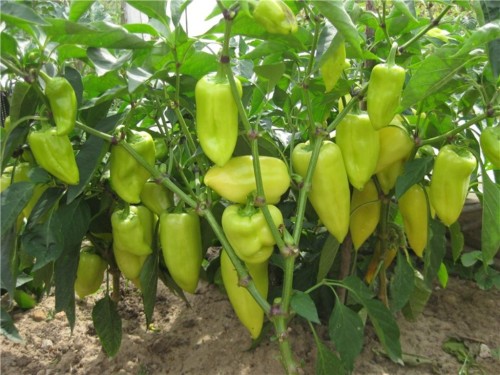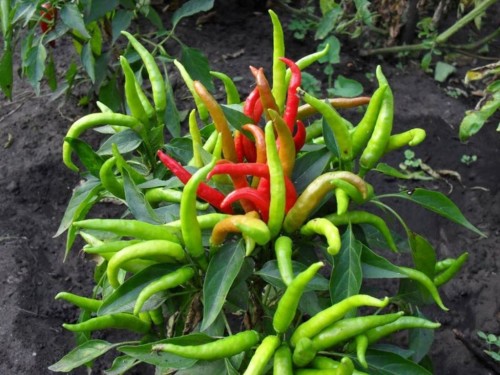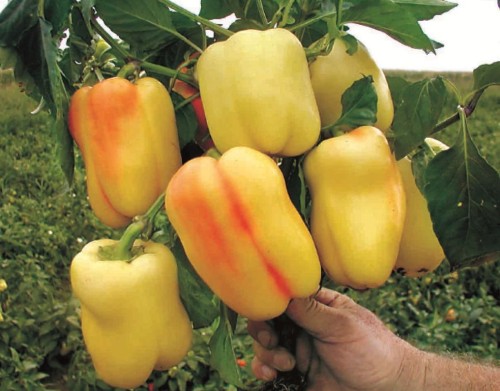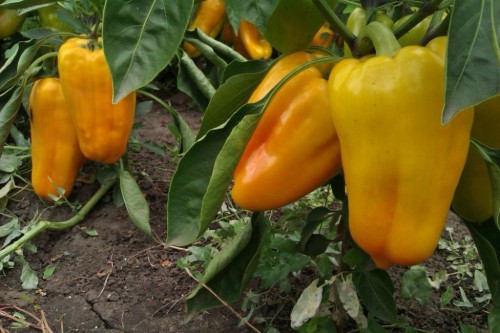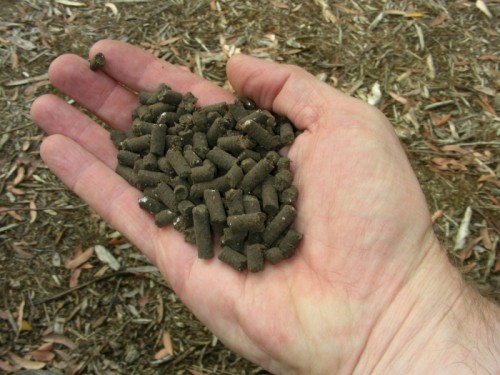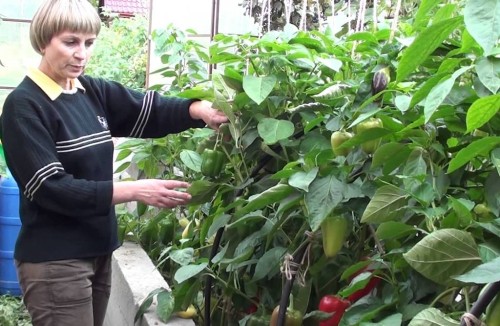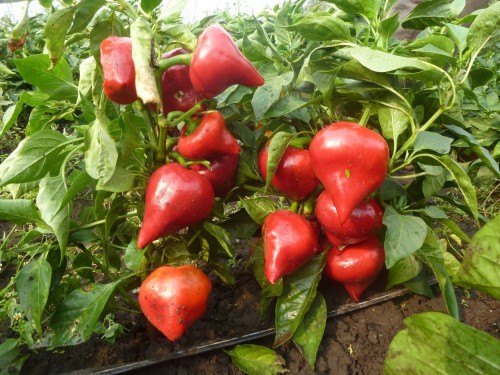
Fertilizers for pepper: funds, norms and features Plot
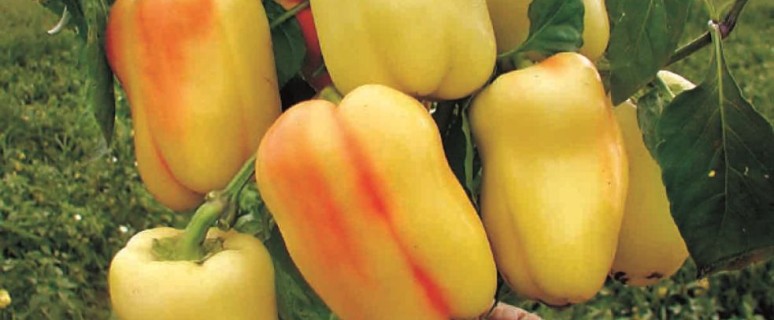
In order to get a rich yield of pepper in autumn, it is necessary to regularly feed the plant throughout its growth, starting with seedlings. The main condition is to choose the proper fertilizer for pepper, know the exact rules and features of the application.
Content
Pepper varieties
Today, this useful vegetable is bred around the world, and its homeland is considered to be America. All existing varieties of peppers are divided into two types: Sweet and bitter. And sweet, and bitter peppers have a huge variety of zottochips. What does pepper look like depending on the variety, you can see in the photo:
Pepper loves a lot of light, does not tolerate increased humidity and strong drafts. The best soils for culture are lightweight sampling or drum and in no way sour. The predecessors can be cabbage colored and white, cucumbers, onions and all legumes. It is forbidden to plant peppers after tomatoes and eggplants - they are subject to the same diseases as pepper. On the same place to plant pepper is recommended every 4 years. If you do it more often, then plants may be infected with accumulated pests and diseases.
In the fall, the soil is prepared for the cultivation of pepper immediately after harvesting precursors - first make useful substances, then plow and conduct cultivation. In the spring, leveling harrowing is carried out, then alignment and in conclusion, in front of the seedling plant itself, cultivation up to 15 cm in depth.
Feeding pepper seedlings
Before hanging out the pepper seeds, it is necessary to prepare the soil for seedlings. The best organic fertilizer for soil will be manure or peat compost - per 1 square meter. M Earth contributes 3-4 kg. Perfect pepper seeds in the ground, which supported straw with nitrogen additives.
It is very important to feed pepper seedlings during its growth so that healthy plants have grown out of it. Already after the first portion of fertilizer, you can see the fruitful effect of it on pepper seedlings. But this does not mean that you can stop and no longer fertilize plants.
Most of all, fertilizers such as urea and superphosphate are suitable for feeding seedlings. And it is strictly forbidden to feed the chloride chloride seedlings, it can destroy the young seedlings.
Feeding seedlings takes place in the following order:
- When the first leaflets appear on the seedlings, they conduct a dive and after 2-3 weeks the first feeding of pepper seedlings is carried out. On 10 liters of warm water, 30-40 g of superphosphate are taken, insist during the day, then 10 g of ammonium nitrate, 30 g of potassium sulfate and 10 g of urea are added.
- Before you begin to enter the fertilizer, it is necessary to spray the seedlings, and the earth is pouring.
- Under each seedling, 50-100 ml of solution contribute and again watered with a small amount of water. This is done in order to wash away from the leaves by chance that the droplets of the solution.
- Excellent fertilizer for pepper seedlings - the litter of birds and the alcohol. The litter is divorced by clean water in a ratio of 1 to 5, and manure is 1 to 10.
- Micromelements in connection with water are also successfully used as fertilizer. It can be a sulfate zinc (10 liters of water 0.5-1.5 g), boric acid (10 liters of water 1-2 g), potassium-manganese (10 liters of water 1.5-2 g), copper vigorous or ash (on 10 liters of water 2 g of vitriol or 200 g of ash).
Pepper feeding on the open soil
After the seedlings landed into the open ground, the feeding continues throughout the growth of the plant up to the appearance of the first fruits on the bushes and their maturation.
Pepper feeding on the open soil is carried out in several stages:
- The first feeding of pepper is held 15-20 days after landing in the open soil. During this time, seedlings will have time to take care, grow and will be ready to take fertilizers. For the first feeding, it is necessary to dilute 5 g of superphosphate and 10 g of urea, add to the bucket with water. Then it is necessary to thoroughly mix the solution and pour 1 liters of water under each seedling. It is advisable to do it carefully not to get on the leaves of the bush.
- The next feeding is carried out during the tying and ripening of pepper buds. At this time, pepper most needs such an element as potassium. It is necessary to dilute 1 tsp. Potassium in the water bucket, add 1 tsp. Carbamide and 2 tbsp. l. Superphosphate. Mix well and pour 1 liter of solution for each bush. Superphosphate is recommended to add in case the soils are deprived by phosphorus.
- Finally, the third feeding is carried out after the ripening of the first fruits on the bush. It takes 2 hours. L. Superphosphate, 2 h. Potash salt and divorced in 10 liters of water. Everything is mixed and the same as in the first two feeders, 1 l of the solution is poured under each bush of the plant.
- If you have noticed that the pepper bushes began to grow badly, it is necessary to help their carbamide. It takes 30-35 g of carbamide on the water bucket, stirred and spray plants for 6-8 days.
- Beautiful fertilizer for peppers can be infusion of young nettle on water with the addition of minerals. The bucket is filled with nettle to the top and poured water. Approximately a week later, the tincture begins to wander. After another 2-3 days, nettle drops on the bottom of the bucket, now the tincture can be strain and add mineral fertilizer. Tincture is ready. If you do not add mineral fertilizers, it is possible to water the pepper every 10 days, it is absolutely harmless.
Fingering pepper grown in greenhouses
Oddly enough, but the pepper grown in greenhouses is fertilized by fertilizers in a separate scheme. Organic fertilizers effectively affect the amount of harvest, and minerals are responsible for the growth of bushes:
- The first feeding is necessary after 14 days after disembarking seedlings in the ground. It is carried out with a mixture of bird litter or a cowboat with water. Take 15 parts of water for 1 part of the litter and 10 parts of water on the 1st part of the cow. The resulting solution in the amount of 1 liter ferter each bush of the plant. Additionally, you can feed pepper by potassium and superphosphate.
- After the bloom itself, you can spend the second feeding of pepper. For her, a mixture of a cowboat with water is taken, and in addition mineral fertilizers.
- As soon as the first harvest ripes, it must be removed and spend the third feeding of vegetables. For her, they use exactly the same scheme as for the second feeding.
- If the soil in the greenhouse is very exhausted, you can spend the fourth feeder. It uses a mixture of superphosphate with mineral fertilizers.
Additional feeding pepper
Sometimes, in addition to the main fertilization scheme, additional feeding is carried out. This is necessary if you see that the bushes suspend their height, they bloom badly.
Additional feeding is carried out in this way:
- If the bushes give good growth, but bluntly bloom, stop feeding the plants with nitrogen, but add water superphosphates.
- If the pepper leaves begin to twist, you need to add potash fertilizer to the soil.
- The purchase of matte-gray leaves from the bottom indicates a shortage of nitrogen fertilizers in the soil.
- During the growing season, peppers may need spraying of bushes, since the plant is so faster assisted fertilizers.
- Do not overdo the fertilizer. This is not the case when the greater the better. Particularly impossible to abuse the dunglaze, it can lead to fertility loss.
Useful advice
When feeding pepper, it is necessary to consider what fertilizer is for what is intended to affect and what can be in overdose:
- It is impossible to abuse organic fertilizers immediately before falling down pepper. Their part is made to the predecessors.
- Full dose of phosphorus minerals and potassium is brought in autumn under plow, then during the sowing and with feeding in the growing season.
- Part of nitrogen fertilizers contribute before sowing and with feeders or completely the entire norm during the growing season.
- Nitrogen fertilizers effectively affect the number of obscenities and the size of the fruit, and the excess of this fertilizer can lead to a delay in maturation and to a decrease in the immunity of plants to diseases. The lack of nitrogen leads to the loss of pepper fertility and to the oppression of the plant itself.
- If there is a necessary amount of phosphorus in the soil, the rate of ripening of fruits will increase, and the roots of the bushes will be strong. The lack of phosphorus leads to the acquisition of purple leaves.
- Potassium contributes to balancing vitamins and carotes, and this in turn improves the cellular structure of fruits and has a positive effect on the brightness of the color. The lack of potassium leads to redness of the edges of the leaves.
- The lack of magnesium leads to twisting and yellowing of foliage.
- Before entering fertilizers, it is advisable to hold a special soil analysis to certainly know what additives the plant needs.
Summing up, we can say that feeding pepper and its seedlings fertilizers is of great importance for obtaining a rich vegetable crop. It is important to introduce fertilizers is normalized and according to the scheme, not abusing and not overproing culture. The plant behind which was correctly calmed, focused on time and fed, be sure to thank you with good growth and useful juicy fruits.




